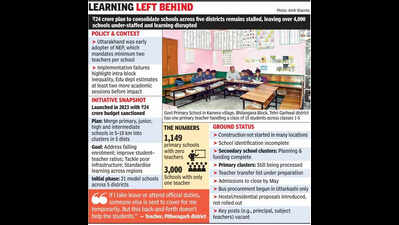- News
- 2 years on, Uttarakhand’s cluster school reforms remain stalled
2 years on, Uttarakhand’s cluster school reforms remain stalled
Dehradun: Two years after Uttarakhand announced an ambitious plan to restructure its public school system through the creation of cluster schools, the programme remains largely dormant. Announced in 2023, the initiative was designed to merge nearby primary, junior, high, and intermediate schools into single clusters to address declining enrolment, uneven student-teacher ratios, and deteriorating infrastructure. While Rs 24 crore was sanctioned to develop the first 21 model schools across five districts, little has materialised beyond the paperwork.
The model, on paper, appeared sound. Clustering schools within a 5-10km radius was expected to pool resources, attract better-qualified staff, and create spaces where learning could be standardised. The reality, however, is that many of these schools are yet to see construction begin. Even the identification of which schools will be merged remains an incomplete process in several areas. The state's educational imbalance continues to widen — and not just between districts, but from one block to another, or even between neighbouring villages.
In a recent report, TOI highlighted a telling contradiction: a govt school on the outskirts of Dehradun was being run by two teachers catering to just one student. Meanwhile, the state's migration commission flagged that 1,149 primary schools had no teachers at all, and another 3,000 had only one. These figures reveal more than bureaucratic inefficiency; they point to a system that is drifting steadily away from its constitutional mandate to provide equitable education.
"There are several schools in Chakrata block where a single teacher is responsible for as many as 30 students," said Raghuveer Tomar of the Uttarakhand Teachers' Association. "In Mehrawana and Naylee, it's one teacher for an entire primary section. But in schools like Mindal, there are two teachers and only five students. Even within one block, the imbalance is staggering." He added that the New Education Policy, which Uttarakhand was among the first states to adopt, stipulates at least two teachers per school — a guideline not being met in most cases.
In Rampur village, located in Ramnagar, the retirement of a govt school teacher left students without instruction for nearly nine months. Appeals from local families went unanswered. Eventually, in protest, villagers locked the school and refused to send their children. "Our village was declared a revenue village only in December," said Ramesh Chandra, president of the school management committee. "Until then, we were Van gram. But regardless of status, children here deserve a teacher. Even basic administrative tasks require a teacher's presence, and burdening a single person with everything — from lesson plans to government forms — is not a sustainable solution."
Though one teacher was eventually posted, residents say the appointment is temporary and does not meet the village's long-term needs. "There are 43 students, and one teacher," said Chandra. "We want more than a stopgap measure." He also pointed out that the upper primary school in the same village has only two teachers, despite a sanctioned principal post that remains vacant. A Hindi teacher is urgently required, but repeated requests have gone unanswered.
State education officials say efforts are ongoing. In Bageshwar, where construction for several cluster schools is in early stages, officials said data on student enrolment and teacher availability is being compiled. A list for teacher transfers is also under preparation, and admissions for the upcoming academic year are to be completed by May.
Mukul Kumar Sati, director of secondary education, said that while plans for secondary-level cluster schools have been finalised, the process is still underway for primary schools. "We've identified where clusters will be formed, and the infrastructure requirements have been outlined," he said. "Resource allocation is complete for secondary schools. Primary schools will follow."
Meanwhile, the state has begun procuring school buses in districts such as Uttarkashi to transport children from remote villages to designated hub schools. A proposal to develop hostels and residential facilities has also been introduced. But these steps remain partial and scattered, with sources in the department indicating that it could take at least two more academic sessions before any significant on-ground changes are visible.
(With inputs from Sonali Mishra in Nainital, Prem Punetha in Pithoragarh, and Yogesh Nagarkotiu in Bageshwar)
End of Article
FOLLOW US ON SOCIAL MEDIA











